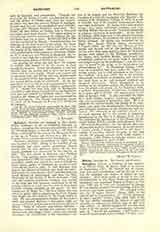

Bathurst, Diocese of, situated in New South Wales, Australia, in the ecclesiastical Province of Sydney, comprises the territory immediately west of the Dividing Range; it extends north to the Barwon River, is bounded on the west by the Macquarie River as far up as Warren and thence by a line to the Lachlan River twenty miles below Eauabolong.
HISTORY.—Bathurst (population in 1901, 9,223) was founded in 1824. Owing to the hostility of the aboriginals and other causes, population filtered slowly into the rich Bathurst plains till the first paying goldfield was discovered in the district, in 1851. The first church in Bathurst, says Cardinal Moran, “was nothing better than a bark hut”. It was superseded in 1861 by a fine new edifice (now the cathedral), which was erected at a cost of £12,000 by Dean Grant, pastor of Bathurst for nearly twenty years till his death in 1864. In 1865 Bathurst, then part of the Diocese of Sydney, was made the cathedral center of a new diocese, which extended from the River Murray to Queensland, and from the Blue Mountains to the border of South Australia. That vast and sparsely populated territory was divided at the time into five missions, ministered to by six priests, with seven small churches and six state-aided Catholic schools, attended by 492 pupils. Its first bishop was the Right Rev. Matthew Quinn, who had taken an active part in organizing the Irish Brigade that fought for the defense of the Papal States in 1860. He was consecrated in Dublin, November 14, 1865, and reached Bathurst November 1, 1866, accompanied by five priests and seven pioneer Sisters of Mercy. Years of toilsome organization followed—laborious visitations; opening new missions and supplying them with clergy; church, school, and convent extension; the introduction of the (Australian) Sisters of St. Joseph and the Patrician Brothers; the founding of a Catholic newspaper, the “Record”; the erection of St. Stanislaus’ College, in 1873, at a cost of £15,000, and of St. Charles’ Ecclesiastical Seminary eight years later. Dr. Quinn was a man of great energy, deep piety, cultivated intellect, and, says Cardinal Moran, was one of the “foremost champions of religious education in Australia“. At his death, January 16, 1885, there were in the diocese 28 priests, 56 Catholic schools, 21 convents, 192 nuns, and 5 religious brothers. Dr. Quinn was succeeded by the Right Rev. Joseph Patrick Byrne (consecrated August 9, 1885). In 1887 the new Diocese of Wilcannia was formed out of the Bathurst Diocese. At the same time some districts from the Maitland diocese were added to the Bathurst jurisdiction. Dr. Byrne, says Cardinal Moran, “strenuously and successfully carried on the great work of education and religion begun by his predecessor”, and, like him, was “a model to his clergy in his unwearying and self-sacrificing toil”. St. Stanislaus’ College, which from its foundation had been under the control of secular priests, was in 1888 entrusted to the Vincentian Fathers. It is now (1907) one of the foremost educational institutions in Australia, and noted for the work done in its well-equipped physical and chemical laboratories. When pronounced to be stricken by an incurable malady, Dr. Byrne received from his priests and people, on the Epiphany, 1901, a pathetic demonstration of affection, accompanied by a money gift of £2,530. He passed away on the 12th of January, 1901. To him succeeded the Right Rev. John Dunne—builder, missioner, organizer—who was consecrated September 8, 1901. He is to complete the architecturally fine college of St. Stanislaus, and under his administration the missionary and scholastic traditions of the diocese are well sustained. The efficiency of the Catholic schools is in no small measure due to the system of inspection inaugurated by the Rev. J. J. Brophy, D. D., LL. B. The principal lay benefactors of the diocese are Mr. James Dalton, K.S.G., and Mr. John Meagher, K.S.G.
RELIGIOUS STATISTICS.—In the diocese there are: 18 parochial districts; 89 churches; 29 secular priests; 7 regular priests; 7 religious brothers; 242 nuns; 1 college; 8 boarding schools for girls; 11 day high schools; 39 primary schools (with 3,496 pupils); 1 orphanage; 4,298 children in Catholic schools; and a Catholic population of about 27,000.
HENRY W. CLEARY

